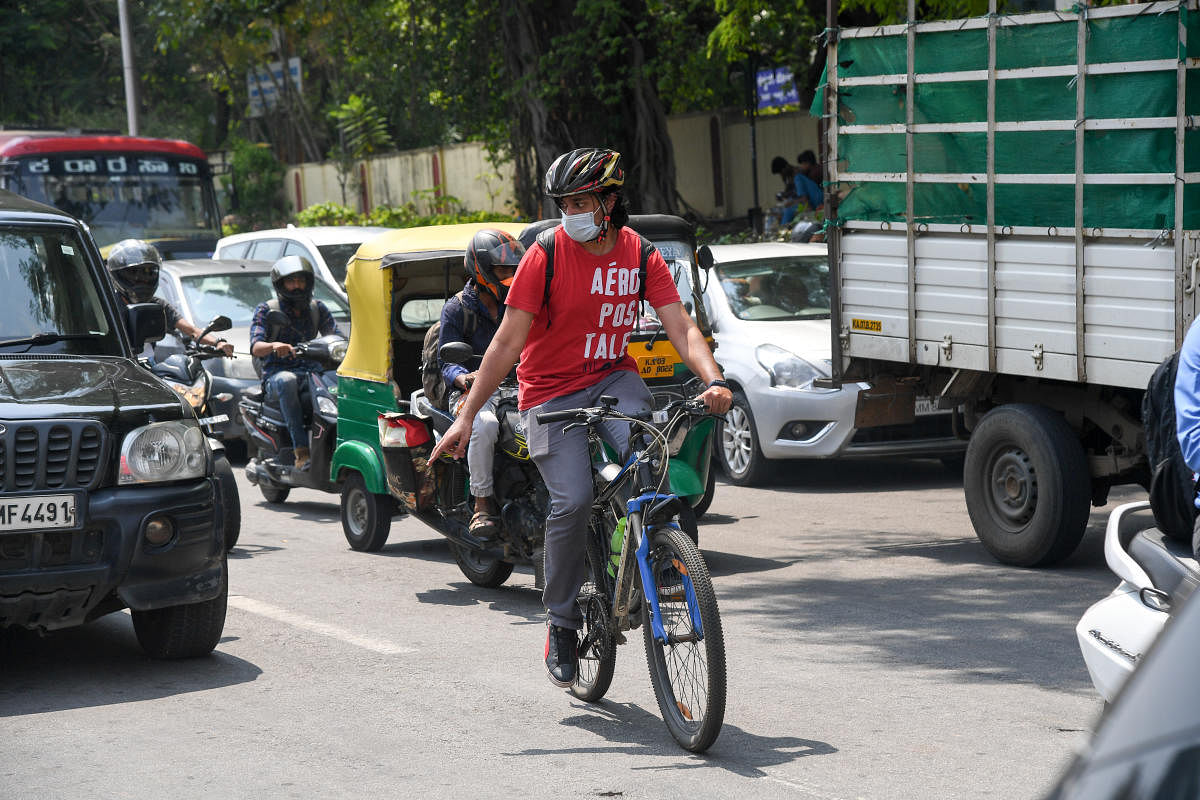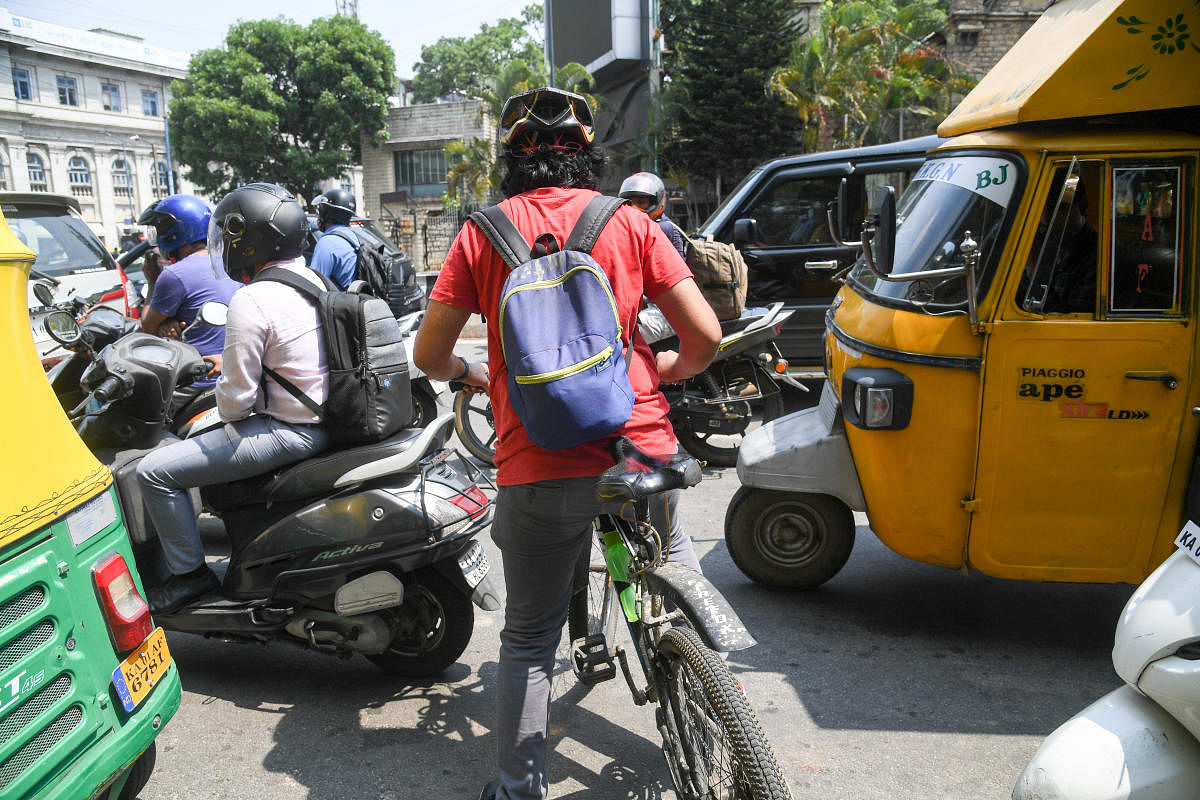

"Maybe I gave up too soon last time,” I told my colleague, explaining why I had agreed to do a story on cycling to work.
I had first decided to ride to work on my geared cycle in October last year. Up and down, it was an 18 km ride. I gave up in two days because the traffic, made worse by the smoke and the rains, had made the experience exhausting.
It was nothing like taking weekend rides on the outskirts of the city. Out there, I enjoy the scenic views, clean air, and smooth roads, and can ride 60 km without much care. This time around, I had agreed to try cycling for everything at least for four days.
Work diary
I get ready to cycle to the office on M G Road, 9 km from my house in J P Nagar. I start at 1 pm. Pedalling past Jayanagar and Yediyur is a breeze, and so is the downhill ride to Sajjan Rao Circle. No potholes yet. The weather is also on my side. As soon as I hit Minerva Circle, I am reminded of why I gave up last time.
A tsunami of cars, bikes, buses and trucks sweeps onto the junction and I am the only cyclist as far as my eyes can see. Before I can even drift to a little space on the left side of the road, a biker hijacks it, dangerously. It is a close shave. I wish I had a pair of eyes on the back of my head to watch out for these reckless riders. It also reminds me of a quote by the Brazilian F1 legend Ayrton Senna — 'If you no longer go for a gap that exists, you're no longer a racing driver.'
I look around for some wiggle room now. I am trapped. Vehicles are parked to my left. A cycle lane would have been nice, but there is none here on J C Road. Cyclists tend to ride closer to the left to avoid
being knocked down by speeding vehicles. Yes, roads are for all, but the ones racing are often furious with slower road users like people from the cycling community. Cyclists are made to feel guilty for being out there and are bullied with incessant honking. As if this weren’t enough, the civic bodies dig up roads and footpaths, and care little about cyclists’ safety.
I shake off my thoughts and drift to the middle lane. I brave more impatient, indignant motorists. Along Sree Kanteerava Stadium, the ride gets less stressful. It is a tree-canopied stretch and also wide. The nice ride comes to an end sooner than I would have liked. I pedal on a narrow and sunny stretch of Kasturba Road to get to the office. The time I have taken, 30 minutes, isn’t too bad. It would have taken me longer, or at least as long, had I taken the Metro or an auto. A bus would have definitely taken longer.
On arrival, I yank my cycle’s lock out and tether it to a lamppost because there is no cycle parking in sight. I remove my helmet. My hair is sweaty and I am a mess. A majority of workplaces don’t have bathrooms where their employees can shower. If cycling to work has to become a norm, showers are a necessity. I splash some water on my face and change into a fresh shirt.
It’s 11 pm when my work is done. The weather is pleasant and the traffic has calmed down — but that’s not always a good thing. Motorists tend to zip faster on empty roads, which could put me in danger, despite the red blinker I have attached behind my seat, the blue light I have fixed to the tyre valve, and a helmet secured tightly on my head.
The government data shows that accidents
involving cyclists rose from 3,673 in 2018 to 4,196 in 2019. In the state of Karnataka, 128 cyclists were grievously injured, the data pointed out. Thankfully, I get home in one piece.
A lane for all
The next morning, I take a longer route — a 17 km cycle lane that was built along Outer Ring Road (Agara to Marathahalli) a year ago. It is separated from the rest of the road with traffic cones in some stretches. The lane is divided into two sections — one meant exclusively for cycles, and another that is to be shared by cyclists and pedestrians or two-wheeler riders, marked out in different colours.
I get to the cycle lane along Agara lake, a favourite destination for morning jogs and sunset views. This ought to have been the most enjoyable stretch of the journey but, sadly, cycling is not easy here. With the traffic on the main road not moving an inch, some two-wheeler riders intrude into the cycle lane. A few apologise, most are indifferent.
As I approach Bellandur, Kadubeesanahalli and Marathahalli, hubs for tech parks and gated communities, I am frequently forced to slow down or stop. Motorists are not only dominating the cycle lane but also driving in the wrong direction and honking wildly. I am caught in the vehicular crossfire. If my office were anywhere on this road, I would definitely take a cab.
Cyclists will tell you how reassuring it is to have a motorist behind you wait patiently as you pedal uphill or negotiate a tight corner. Patience and empathy will go a long way in bringing the cycling culture back to Indian cities. But for that, motorists need first to hop on to cycles, and look at the world from another perspective.
Parking woes
Bengaluru has a dearth of dedicated cycle parking: you have to tether your cycles to trees, lampposts, or poles with signboards. Or park in a two-wheeler zone.
On the third day, I am out to a grocery store in my neighbourhood and the security guard lets me park my cycle in a space marked for two-wheelers. I don’t have a lot to buy but in the 15 minutes I spend at the store, I check on my cycle twice. At work, I check every two hours. Theft of headlamps and seats is a talking point in the cycling community.
A mall I visit later in the day also allows me to park my cycle in the two-wheeler zone for a fee of Rs 10. I feel confident about the safety of Rs 15,000-cycle as security guards are around.
On the last day, I ride to a five-star hotel on Race Course Road to catch breakfast. A few years ago, a man was denied entry to a luxury hotel because he arrived on a cycle, I had heard. Times have changed. Cycling is seen as cool and hip, so no one bats an eyelid as I head to the buffet counter in sweaty clothes and sweatier hair. The receptionist chats with me. “A couple of years ago, I used to cycle from R T Nagar, take a shower, and begin work. Now I ride a scooter. The traffic situation is so bad that I can’t think of cycling,” he explains.
After breakfast, I head to the cycling track dotting the Race Course Road. It is done well and runs for a good kilometre. It comes to an end and I ride down on the main road alongside other vehicles for 300 metres before I find another 700 metres of cycling track along Raj Bhavan Road. I wish the lanes were continuous — discontinuity breaks the flow and momentum.
The lack of parking spots for cyclists at the Namma Metro stations is discouraging in a city that talks about integrated urban mobility. The R V Road station is the closest to my house. It has no dedicated parking for cyclists. Which means I have to tether my cycle with a lock around a park fence, which would likely obstruct pedestrians. Newer stations on the green line, such as Konanakunte Cross, Doddakallasandra, Vajarahalli, and Thalagattapura, have also not delivered on the promise of dedicated cycle parking. The Silk Institute station is an exception on this route. It offers cycle parking on a site adjacent to the station for Re 1 an hour and a maximum of Rs 10 all day.
What are the lessons from four days of pedalling on our roads? Cycling is best for short rides, say, to go grocery shopping or meet a friend in the neighbourhood. For tasks that require going into busier commercial
areas, motorised vehicles are still the safest bet. As things stand, Bengaluru’s vision of becoming a
cycle-friendly city like Amsterdam, Brussels and Copenhagen remains just a PowerPoint presentation.
97% of commutes are motorised
Currently, cycling accounts for only 3% of all daily commutes in Bengaluru. This must rise to 10% for Bengaluru to justify the ‘cycle-friendly’ tag, says Sathya Sankaran, cycle mayor of Bengaluru.
“If you’re building a road, a cycle track and a footpath must be built mandatorily… People today are not cycling because the segregated infrastructure does not exist. The low count of people making trips on the cycle cannot be an excuse to avoid building such infrastructure,” he says.
Sathya lauded the Karnataka government’s commitment to building 600 km of cycle tracks in the next 15 years but the progress is far from satisfactory. They have laid just 20 km since 2020, he points out.
He would also like the government to expand the bicycle sharing service (currently offered by Yulu, in partnership with the Directorate of Urban Land Transport) in Bengaluru in a big way. This should come up at metro, railway and bus terminals, he says.
Finally, the use of the cycle as a mode of commute must be incentivised. The Metro should offer concessions to cyclists and companies should encourage employees pedalling to work, he suggests.